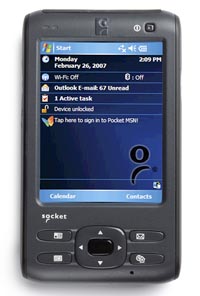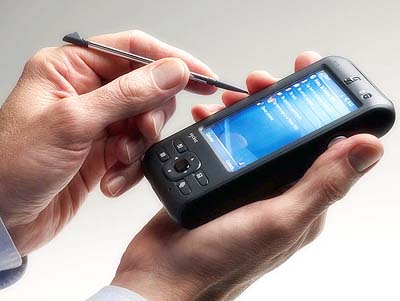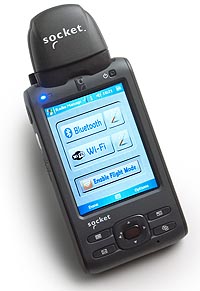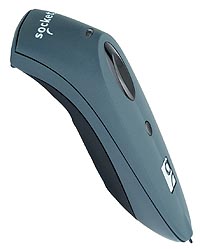|
Socket SoMo 650 Mobile Computer
A Business Class Mobile Computer
(by Conrad H. Blickenstorfer)
 Socket Communications has been known for almost 15 years for its comprehensive line of mobile computing peripherals. It thus came as somewhat of a surprise when the company announced in early 2007 that it was going to have its own mobile computing device line. The company felt that offering customers a handheld computer in addition to its broad range of pre-tested and pre-configured peripherals would eliminate a lot of the risks and complexities customers encounter when purchasing mobile systems; after all, they could buy both the handheld and all the necessary peripherals from the same company. No integration and incompatibility hassles. Makes sense.
Socket Communications has been known for almost 15 years for its comprehensive line of mobile computing peripherals. It thus came as somewhat of a surprise when the company announced in early 2007 that it was going to have its own mobile computing device line. The company felt that offering customers a handheld computer in addition to its broad range of pre-tested and pre-configured peripherals would eliminate a lot of the risks and complexities customers encounter when purchasing mobile systems; after all, they could buy both the handheld and all the necessary peripherals from the same company. No integration and incompatibility hassles. Makes sense.
The result is the SoMo ( for "SocketMobile") 650 Mobile Computer, a semi-rugged, state-of-the-art Pocket PC designed for duty in business mobility applications including sales force automation, inventory management, patient care, merchandising and asset management. Socket created the SoMo 650 to fit inbetween standard Pocket PCs that are not tough enough for industrial jobs and the much more expensive rugged devices that may be overkill. Socket succeeded nicely in striking an impressive balance between performance specifications, ergonomics, and a nearly endless lineup of options. Socket targets the 650 at what it calls "gray collar" workers -- skilled technicians whose jobs combines blue and white collar duties. They are on often on the go and need a durable handheld.

What is the Socket Mobile 650?
The Socket Mobile 650 is a "traditional" handheld computer, one that still looks like PDAs looked before they all morphed into some sort of smartphone. Compared to them, the SoMo 650 is relatively large. It measures 5 x 2.95 x 0.81 inches and weighs just over six ounces. It has a nice-sized 3.5-inch LCD display so you can actually read what is on the display. The body is made of tough almost black plastic. The overall design is rectangular, but corners are rounded and edges smoothed both for impact protection and ergonomic reasons. The sides are protected with seamlessly integrated black rubber strips.
Taking a look from all sides, the front of the 650 sports a 5-way navigation button flanked by two application bottons on each side -- Calendar and Messaging on the left and Contacts and Today on the right. At the bottom right is a small hole for the microphone (placed so that the 650 can be used as a VoIP communicator). The power bottom is on the right above the screen. On the upper left is a blue/green LED that shows Bluetooth and WiFi operation, and a red/green one that signals alarms and battery charging.
Turn the unit around and find a smooth backside with a large user-accessible compartment for the 650's 3.7 Volt/1,200mAH Li-Ion battery pack. To the right of it is the speaker, and that's it for the backside.
Along the left side, from top to bottom, you find a hands-free headset microphone connector, a programmable application button, a "hold" switch, and the DC power connector at the bottom. The right side is unadorned except for a single programmable application button.
On the bottom is the USB synchronization/host cable connector for the dock. On top there is a tight-fitting rubber cover below which you find a Compact Flash Type II slot and a SDIO card slot. To the right of the cover is the garage for the nicely integrated stylus.
Under the hood
The SoMo 650 uses the fast 624MHz version of the Marvel PXA270 processor, comes with 128MB of SDRAM and 256MB of FLASH, and has Bluetooth and 802.11b/g wireless LAN capabilities. All these specs are generous for a device of this nature, and make for a powerful, competent platform that can get the job done.
Speedy wireless
WiFi and Bluetooth are available in many handhelds these days and so it is good to see exactly what kind of WiFi and Bluetooth implementations a device comes with.  The 650 comes with 802.11b/g WiFi, and the difference between a simple 802.11b and the much faster 802.11b/g is simply amazing. Web browsing used to be painful to impossible on a Pocket PC. With its fast processor and fast WiFi, the 650 loads pages quickly and makes browsing and the use of web-based applications productive rather than a frustrating waste of time. Bluetooth likewise is speedy. Socket used Version 2.0 with EDR, which stands for "Enhanced Data Rate." This is also a "fast roaming" device, which means it can switch fom service to service in less than two tenths of a second. That can be invaluable for dependable wireless communication and VoIP (Voice over IP) applications. The picture on the right shows the 650 with the optional CompactFlash Scan Card, and the Wireless Manager utility on the screen. The utility is quite powerful. Click on WiFi tools and you get a graphic real-time representation of all aspects of your wireless connection, down to packets sent and received, line quality, connection duration, security and more.
The 650 comes with 802.11b/g WiFi, and the difference between a simple 802.11b and the much faster 802.11b/g is simply amazing. Web browsing used to be painful to impossible on a Pocket PC. With its fast processor and fast WiFi, the 650 loads pages quickly and makes browsing and the use of web-based applications productive rather than a frustrating waste of time. Bluetooth likewise is speedy. Socket used Version 2.0 with EDR, which stands for "Enhanced Data Rate." This is also a "fast roaming" device, which means it can switch fom service to service in less than two tenths of a second. That can be invaluable for dependable wireless communication and VoIP (Voice over IP) applications. The picture on the right shows the 650 with the optional CompactFlash Scan Card, and the Wireless Manager utility on the screen. The utility is quite powerful. Click on WiFi tools and you get a graphic real-time representation of all aspects of your wireless connection, down to packets sent and received, line quality, connection duration, security and more.
Software and utilities
On the software side, the 650 comes with all the usual Windows Mobile 5.0 Premium Edition applications (Mobile versions of Word, Excel, PowerPoint and Internet Explorer, a flexible mail client, Pocket MSN, and so on. There is also a slew of Socket-specific applications, including Mobile Connect!Agent, Mobile Wi-Fi Companion, Mobile SocketScan, Mobile Modem Utilities, Mobile Ethernet Utilities, and Mobile Serial I/O Utilities. Socket also offers special software development kits for data collection and wireless LAN applications.
Peripherals galore
The product can be ordered pre-integrated with a range of laser and imager based bardcode scanners and RFID readers (click to see Socket's range of data collection peripherals). This is one of the primary selling points of the Socket Mobile 650: no more guessing what works with what. It ALL works bcause it ALL comes from the same company.

SocketScan with the CHS Cordless Hand Scanner
Those who like their scanner separate from the handheld may choose the small and very ergonomically designed CHS.  It measures 4.9 x 1.2 x 1.4 inches, runs on two AAA batteries (good for over 8,000 scans with a Bluetooth connection), and its available in three configurations -n entry level, mid-range and performance. Thee models differ in power, performance, environmental specs. That's primarily because they use different scanners. The entry level 74 has a Symbol CSE600 CMOS linera imagers whereas the two highg level models use the Symbol SE-955 Class 1 and Class 2 laser, respectively. The entry level product can decode Codabar, Code 11, Code 128, Code 39, Code 93, D 2 of 5, I 2of 5, MSI, UPC/EAN, and Webcode. The other two models can also handle Chinese 2 of 5 and RSS-14 limited and expanded. It measures 4.9 x 1.2 x 1.4 inches, runs on two AAA batteries (good for over 8,000 scans with a Bluetooth connection), and its available in three configurations -n entry level, mid-range and performance. Thee models differ in power, performance, environmental specs. That's primarily because they use different scanners. The entry level 74 has a Symbol CSE600 CMOS linera imagers whereas the two highg level models use the Symbol SE-955 Class 1 and Class 2 laser, respectively. The entry level product can decode Codabar, Code 11, Code 128, Code 39, Code 93, D 2 of 5, I 2of 5, MSI, UPC/EAN, and Webcode. The other two models can also handle Chinese 2 of 5 and RSS-14 limited and expanded.
Anyone who has used Bluetooth connections knows the drill: have the devices discover each other, establish a partnership, and that's that. Socket's SocketScan suite is an integral part of the SoMo 650 and offers powerful features not always found elsewhere. It can convert scanned bar code charactersinto virtual keystrokes, adds prefixes and suffixes as required, can enable or disable certain symbologies, and reports on the symbology used, as well as the length and decoded data of bar codes. Quite sophisticated. You operate the CHS either via its own large button or via a programmable button on the 650. Oh, and the CHS even has a stylus tip on the opposite side of the laser so you can use it as a pen.
SocketScan with the CF Scan Card
Those who prefer intergrated peripherals can use the Socket CompactFlash Scan Card to slides into the CF Card slot on top of the device. Like the cordleess scanner, the Scan Card comes in several models, from the entry-level CFSC 5E whih uses a CMOS linera imager, to the mid-range 5M that uses a Class 1 laser, the performance 5P model with a Class 2 laser, and then the "Xtreme Performance" 5X model that uses a 2D high density CMOS imager that can scan and decode all popular linear, stacked linear, 2D/Matrix and postal bar codes.
The Socket Mobile edge
What all this means is that the hardware is all there. A competent, modern handheld computer designed for a three to five year life cycle; a reliable OS platform with extensive developer support; a large selection of peripherals that all work with the computer as they all come from the same company; reasonable pricing that allows cost-effective deployment in areas where the economics previously just were not there. The Socket Mobile 650 excels in data collection where it can easily do bar code reading of all sorts. It can also do RFID reading and writing as well as magnetic stripe reading.
Another big advantage of dealing with Socket is that the company just offers so many solutions. Whether an application works best with an integrated scanner or a wireless separate model doesn't matter; Socket has both. If both hands are needed at all time, there's a cordless ring scanner. On the connectivity front, it's no different. You can get anything from legacy serial ports and modems all the way to various wireless adapters and technologies, and it all works together. And even the 650's optional leather case excels. It looks and fits (and smells) terrific, and we love the strong magnetic clasps. Or take the cradle. Not only is it a substantial and well built piece of equipment, it fits the 650 even with its extended battery in place, it has a charging slot for a second battery, and it offers two USB ports. Try to find that in a consumer Pocket PC. There simply isn't a weakness anywhere in this entire system.
Bottom line
The Socket Mobile 650's list price of US$695 is very reasonable given the unit's high-end features, power, and expandability. It should be interesting to see how the new Socket device does in comparison with another recent arrival, the Symbol/Motorola MC35. Both are roughly the same size and cost, but Socket banks on power and expandability whereas Symbol emphasized out-of-the-box scanning and added trendy thumb-type phone capabilities. There's likely room for both approaches. Socket's first handheld is well-conceived and well executed, the company's rationale for offering it is sound, and its reputation as a mobile systems peripherals vendor stellar. We felt this way after the product was first announced, and even more so after we've had it in our lab for a month and experienced first hand how it all fit together, and what a reliable speedy product the 650 is.
Updates
On February 25, 2008, Socket announced a new line of products to be built with an antibacterial plastic targeted toward healthcare and other markets that involve hygiene-sensitive environments. The first product combination to debut in the new line is the SoMo 650 handheld computer and docking cradle. The antibacterial product line incorporates the use of an antibacterial additive that gradually releases microbe-fighting metal ions upon becoming moist or wet, providing an additional layer of protection against the multiplication and spread of potentially harmful bacteria and microbes (see Socket release on antibacterial plastic).
|



